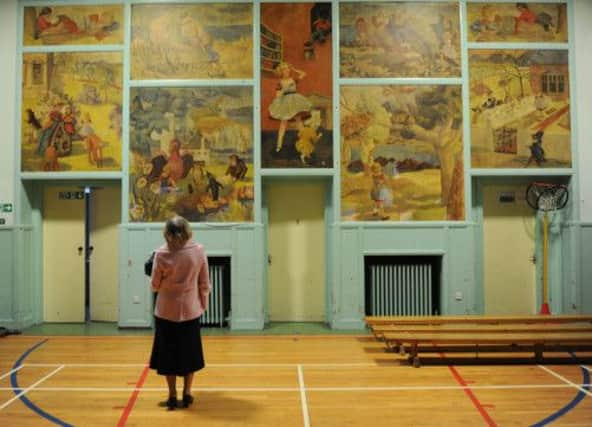Defenders say don’t destroy school Golliwog mural


Politicians, art experts and the son of the Fife-born artist who created it have spoken in support of the mural, since the controversial image was first reported by The Scotsman last week.
The nine-panel mural, featuring children’s character Alice in Wonderland, has been displayed in the school hall at Wardie Primary School since 1936.
Advertisement
Hide AdAdvertisement
Hide AdIt was reported to police by a visitor to the school, Margaret Neizer-Rocha, who spotted it when touring the building to consider applying for a place at the school for her young son. The mural was restored within the past year with a £17,600 grant from the Heritage Lottery Fund.
Ms Neizer-Rocha complained about the “racist and offensive nature” of the picture and has advised that she will send her son to a different school.
But supporters have insisted that the mural is “part of history” and pointed to the fact that no “hate” was intended by artist RH Westwater. Edinburgh Council has insisted that the mural should not be painted over but has provided extra resources to the school for classes on anti-racist issues.
“It’s absolutely ridiculous that anybody is making a fuss about this. Golliwogs did not start to give anyone any offence until relatively recently,” said The Scotsman’s art critic, Duncan Macmillan. “Robertson’s marmalade were using them as a marketing tool until ten to 15 years ago.
The council are right – you can’t paint over things like that. They should appreciate that they have a lovely painting there and use it to their advantage.
“The whole thing has been blown out of proportion. It should be left alone. You can’t change history. It’s there and it’s part of an important art work. The school should take the opportunity it offers as a teaching aid.”
Edinburgh councillor Dominic Heslop said: “The golliwog is part of our culture and history and to pretend otherwise is absurd. The wonderful painting at Wardie Primary School should not be seen as an embarrassment, but rather a symbol of the transition from old perceptions to the 21st century. This is an overreaction and political correctness gone mad.”
In the picture, which covers an entire wall in the school’s sports hall, the golliwog is sitting on a ledge above the Alice in Wonderland figure.
Advertisement
Hide AdAdvertisement
Hide AdMr Westwater’s son, Henry Westwater, of Tain, Inverness-shire, said: “It was painted in 1936, when people’s perception of things was somewhat different. I had a golliwog when I was a small boy; many children did.
“I can see why it could be a bit offensive – I didn’t give our children or grandchildren golliwogs. This woman has every right to complain. But this painting is from another time.”
He added: “For a ‘hate incident’, there has to be a ‘hater’ – and that seems to be missing from this case. The artist is long dead.
“I wouldn’t like the mural to have a bit of it hacked out, but if someone feels strongly enough that it should be painted out and replaced with something else, that would be ok.”
A police spokesman said officers were “liaising with Edinburgh City Council education department” over the complaint.
He added: “Police Scotland treats all reports relating to hate incidents seriously and will investigate whenever a report of this nature is made.”
A council spokesman said: “The Alice in Wonderland mural is of historical and artistic importance. While we understand the offensiveness of the image, it is in no way indicative of the attitudes of either the school or the council. Our equalities policies and approaches are robustly multi-cultural and anti-racist, promoting diversity and good relationships among pupils.”